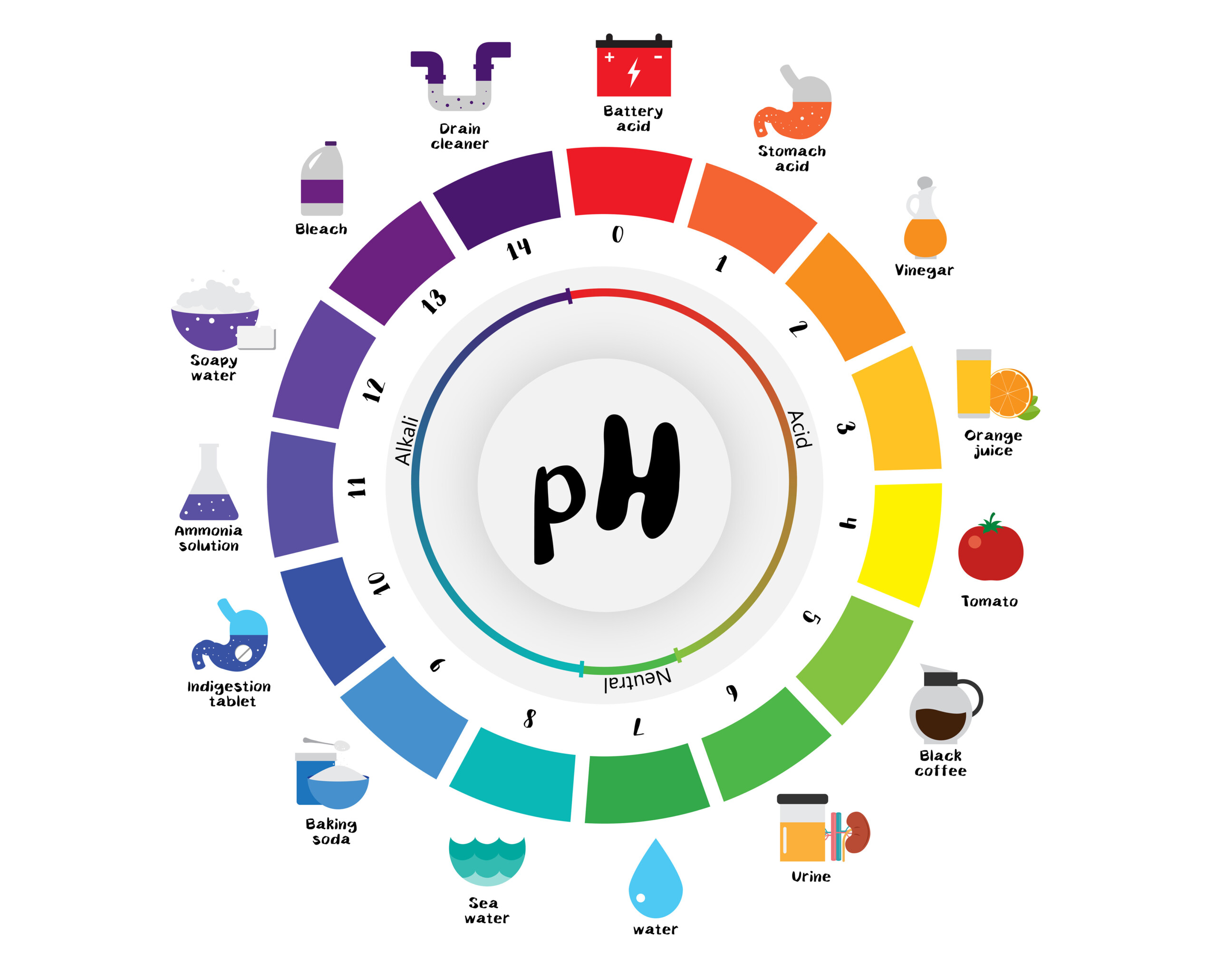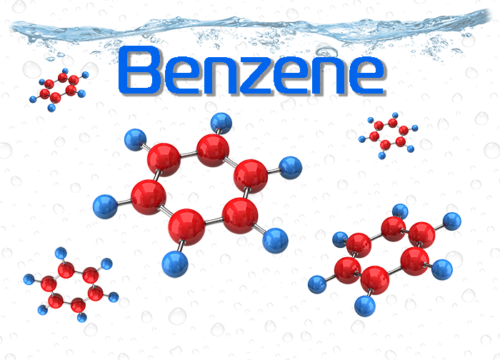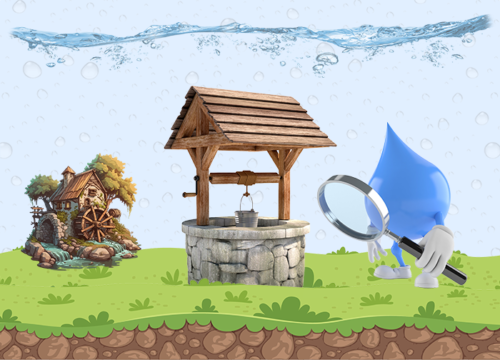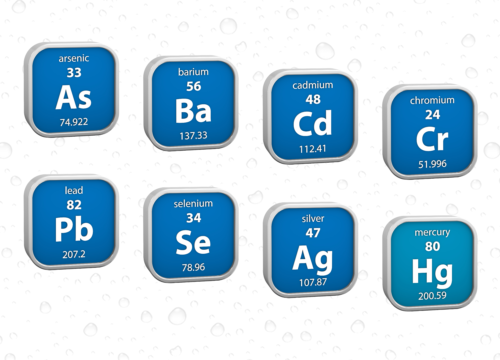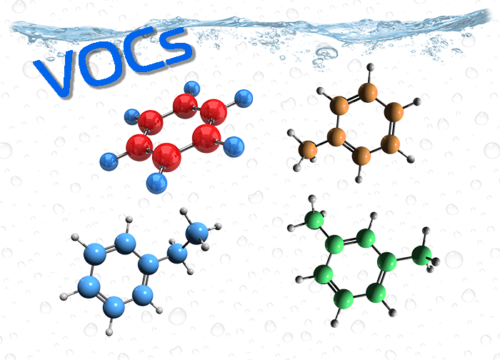The pH of Water
Article originally posted at: https://www.medicalnewstoday.com/articles/327185
In its purest form, water has a pH of 7, which is at the exact center of the pH scale. Particles in the water can change the pH of the water, and most water for use has a pH of somewhere between 6.5 and 8.5.
There are some important things to understand about the pH scale and how it relates to water. For instance, it is possible that drinking alkaline drinks may offer some health benefits.
The pH of water may vary depending on the particles in the liquid.
In chemistry, pH is a measurement of the concentration of hydrogen ions in a water-based solution. A lower pH means that there are more hydrogen ions in the liquid, whereas a higher pH indicates fewer hydrogen ions in the liquid.
In simple terms, pH is a scale from 1 to 14 that measures the acidity or alkalinity of a liquid. In the middle of the scale is pure distilled water, with a neutral pH of 7. Anything with a pH below 7 is an acid, and anything with a pH above 7 is an alkali, or base.
To use everyday examples, vinegar is very acidic, with a pH of about 2. Conversely, bleach is highly alkaline, with a pH of about 13.5.
Importantly, this scale only applies to water-based liquids.
pH plays an important role in the properties of a liquid containing water.
For instance, the pH of water may make certain elements in it, such as minerals and metals, more or less available to the body. Heavy metals in water with a lower pH tend to be more toxic, as they are more available to the body. A high pH would make heavy metals less available, and, therefore, less toxic.
The pH may also be a sign of other contaminants or bacterial life in a liquid. In general, a very high or very low pH can make water unusable for certain applications.
For instance, hard water is the common term for water containing a lot of minerals. These minerals make the water very alkaline. As the water passes through pipes and machines that use water, such as dishwashers or showers, these minerals stick to both the pipes and each other, leading to mineral buildup.
Mineral buildup can cause various issues with water in the home, such as making detergents and soaps less effective. It can also lead to reduced water pressure or even blockages.
On the other hand, water with a low pH may corrode metal pipes and extract metal ions into the water, making it harmful to drink or use in the home.
Most of the time, water that providers intend for use or drinking will stay closer to the neutral point of 7, although it may still vary slightly. The Environmental Protection Agency (EPA) recommend keeping the pH between 6.5 and 8.5 in drinking water, and many states in the United States choose to enforce these levels.
Drinking water and other water-based drinks of varying pH levels may play a role in a few different health factors.
Alkaline water and other alkaline products have gained popularity in recent years, becoming a new health trend. According to advocates of alkaline drinks, acidic environments in the body cause several chronic illnesses, which they claim could not persist in an alkaline environment.
The thinking behind this is that drinking alkaline water helps the body itself to become more alkaline, which will treat a number of illnesses, including cancer.
However, there is little evidence to back up these claims. While drinking alkaline water may temporarily affect the pH of the mouth or urine, there is no scientific proof that it will change the overall pH of the body.
The body strictly regulates its pH levels. Changes in the body’s internal pH, such as blood pH, can mean serious problems in the organs and tissues. So, if it were possible to change the body’s pH using food and drink, it would be dangerous to do so.
However, alkaline water may still be helpful for some people. In general, alkaline water tends to be more alkaline because it has minerals and electrolytes in it. Due to this, drinking this water after a workout or while sick may help keep minerals and electrolytes balanced and prevent dehydration.
Additionally, the findings of a smaller studyTrusted Source suggest that people with acid reflux disease may benefit from drinking alkaline water with a pH of 8.8. The researchers found that alkaline water appears to permanently inactivate an enzyme that plays a role in heartburn, which may reduce symptoms.
Researchers have also found that drinking water with a pH of 8.5–10Trusted Source may be beneficial for people with irritable bowel syndrome (IBS) whose primary symptom is diarrhea. The people who drank water with a pH of 8.5–10 had higher self-reported quality-of-life scores after 8 weeks than those who did not.
However, these are small studies, and more human studies are necessary to back up these initial results.
Learn more about the potential health benefits of alkaline water here.
Labs generally use an electronic pH meter to measure pH accurately. However, it is possible to get a rough estimate of pH using litmus paper. Litmus paper is widely available online and in some stores, such as health food stores and pet supply stores.
Litmus paper is a sensitive strip of paper that changes color when it touches water-based liquids. The change in color can give a rough estimate of the pH of the liquid. A person should keep in mind, though, that these are rough estimates and that the actual pH of a liquid can still vary from what the litmus paper says.
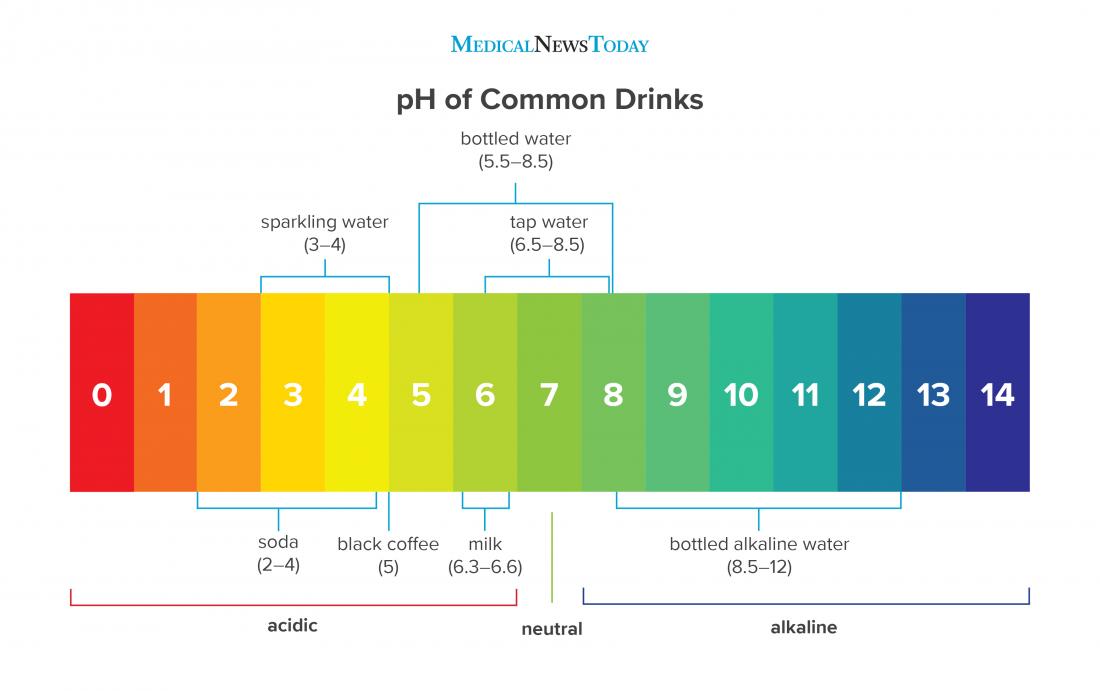
The pH of a liquid will change depending on the ingredients inside. As a result, fluctuations are possible, even in two products that are very similar, such as two types of water.
Here are some general pH ranges for different drinks:
The pH of water for drinking or for use in the home is very important. Water that is too alkaline or too acidic can damage pipes and appliances, and it is generally unhealthful to drink.
Water naturally varies between about 6.5 and 8.5 on the pH scale, and this is normal. Water that is too far outside this scale may not be safe to drink.
Some people may find it helpful to drink alkaline water with a pH higher than 8.5. These individuals include those with digestive conditions, such as IBS. However, larger and higher quality studies will need to back up these claims before experts can make any broad statements about the possible benefits of alkaline water.
Last medically reviewed on December 2, 2019
References
Medical News Today has strict sourcing guidelines and draws only from peer-reviewed studies, academic research institutions, and medical journals and associations. We avoid using tertiary references. We link primary sources — including studies, scientific references, and statistics — within each article and also list them in the resources section at the bottom of our articles. You can learn more about how we ensure our content is accurate and current by reading our editorial policy.
- Drinking water regulations and contaminants. (n.d.).
https://www.epa.gov/dwregdev/drinking-water-regulations-and-contaminants - Fenton, T. R., & Huang, T. (2016). Systematic review of the association between dietary acid load, alkaline water and cancer.
https://bmjopen.bmj.com/content/6/6/e010438.full - Koufman, J. A., & Johnston, N. (2012). Potential benefits of pH 8.8 alkaline drinking water as an adjunct in the treatment of reflux disease [Abstract].
https://www.ncbi.nlm.nih.gov/pubmed/22844861 - Magro, M., et al. (2016). Alkaline water and longevity: A murine study.
https://www.ncbi.nlm.nih.gov/pmc/articles/PMC4906185/ - pH and water. (n.d.).
https://www.usgs.gov/special-topic/water-science-school/science/ph-and-water?qt-science_center_objects=0#qt-science_center_objects - Shin, D. W., et al. (2018). Effects of alkaline-reduced drinking water on irritable bowel syndrome with diarrhea: A randomized double-blind, placebo-controlled pilot study.
https://www.ncbi.nlm.nih.gov/pmc/articles/PMC5925025/ - Weidman, J., et al. (2016). Effect of electrolyzed high-pH alkaline water on blood viscosity in healthy adults.
https://jissn.biomedcentral.com/articles/10.1186/s12970-016-0153-8

